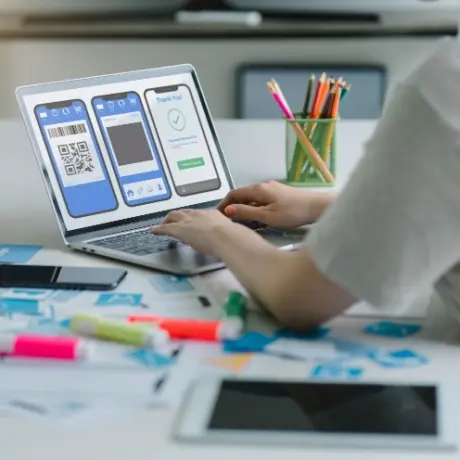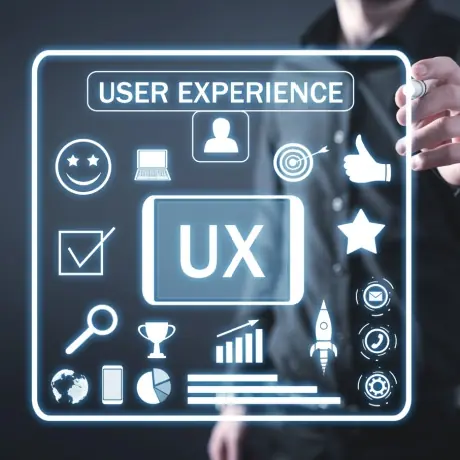Prototyping in UX design is an essential step that takes ideas off the page and turns them into something real. Whether a simple sketch or an interactive model, prototyping helps UX designers explore and test concepts before diving into full development. By creating a prototype, teams can simulate how a digital product will function and gather user feedback. This way, UX designers can improve the user experience long before anything is set in stone. In this article, we’ll explore what prototyping in UX design is, its benefits to businesses, and how it influences the overall design process.
But that’s not all. We’ll also look at why investing in prototyping services is a smart move for businesses looking to deliver successful digital products. From saving time and reducing costs to boosting user satisfaction, prototyping is the key to smoother, more effective product development. Plus, if you’re searching for the right UX design company to partner with, we’ve got some tips for choosing the best fit for your needs. Let’s dive in!

What is Prototyping in UX Design?
Prototyping in UX design involves building a working model of a digital product. This model is used to test ideas, refine concepts, and gather user feedback. It acts as a preliminary step that helps UX designers and teams explore how a product will function before moving into full-scale development. Prototypes are key in UI UX design because they allow for user testing and feedback throughout various stages of the design process. By using prototyping tools, designers create visual representations of their ideas. They also conduct UX audits to pinpoint areas needing improvement. Through UX research and ongoing testing, prototyping helps teams develop user-centered products that align with both business goals and user needs.
Types of Prototypes and Their Purpose
Prototyping allows designers to bring their ideas to life using different types of prototypes. Each one serves specific roles within the design process.
1. Low-Fidelity Prototypes
These are simple, often hand-drawn, and focus on the structure and basic functionality of the design. They are quick to create and help test basic user flows. Low-fidelity prototypes work well in the early stages of design thinking, as they allow teams to brainstorm and refine ideas without getting bogged down by details.
2. High-Fidelity Prototypes
These are detailed and interactive representations that closely mimic the final product. Hi-fi prototypes include colors, animations, and transitions, making them useful for testing user interactions and usability. These prototypes are ideal for stakeholders who need to visualize the final product before approval.
3. Paper Prototypes
Used in the early stages of design, paper prototypes are low-fidelity sketches that showcase user flows and screen layouts. This type of prototype is inexpensive and encourages team collaboration during brainstorming sessions.
4. Digital Prototypes
These high-fidelity prototypes are created using software like Figma or Adobe XD. They simulate the final product and are typically used for usability testing and final validation before development.
5. Interactive Prototypes
Interactive prototypes are digital models that closely mimic the functionality of the final product. They include interactive elements like buttons, animations, and transitions, allowing users to engage with the design as if it were the real product. This type of prototype helps designers test user interactions and gather feedback before full-scale development begins.
Prototyping is critical in design thinking, allowing designers to test ideas, gather feedback, and refine user experiences before full development begins.
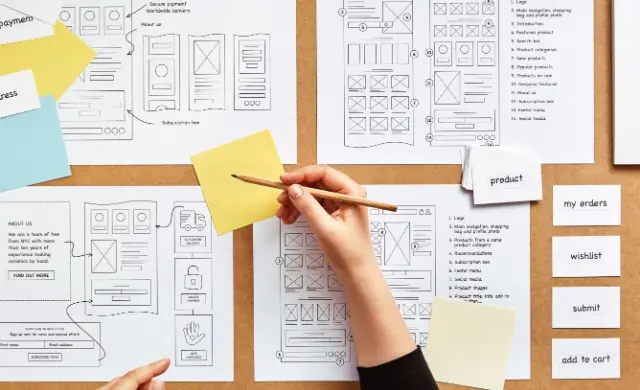
Key Benefits of Prototyping in UX Design for Businesses
Prototyping in UX design plays a critical role in identifying design flaws early, allowing businesses to refine concepts before full development. It helps teams test different design elements and make adjustments before errors become costly. This section explores how prototyping benefits businesses by improving user experience, saving costs, and aligning stakeholder expectations.
1. Identifying Design Flaws Early
One of the most significant advantages of prototyping in UX design is the ability to spot design flaws at an early stage. Prototyping techniques allow UX teams to explore potential issues in the functionality and layout of the product before any significant resources are committed. This reduces the likelihood of expensive redesigns during later stages.
2. Cost Efficiency
By catching errors early, prototyping helps businesses avoid costly fixes later in the development process. Making changes to a prototype is far cheaper than modifying a fully developed product. Additionally, prototyping techniques like wireframes allow for quick iterations, which keep costs low during the design phase.
3. Enhanced User Experience
Prototyping improves the overall user experience by validating design concepts before they are finalized. Prototypes serve as a way to test usability, ensuring that the product meets user needs. Through useful prototyping, the design team can incorporate feedback and refine the user-centered design continuously, leading to higher user satisfaction.
4. Faster Iteration and Refinement
Prototyping facilitates rapid iteration and refinement of designs. Through repeated testing and user feedback, design teams can adjust and improve the product in a dynamic and agile manner. This iterative process not only leads to better design outcomes but also speeds up the time to market by ensuring that potential issues are resolved early.
5. Stakeholder Alignment
Prototypes serve as valuable communication tools that help align stakeholders with the design vision. By providing a tangible model of the product, stakeholders can visualize and provide input early in the design process. This leads to greater involvement, better collaboration, and ultimately, a product that meets both business objectives and user expectations.
These benefits make prototyping a valuable investment for businesses seeking to develop successful, user-friendly digital products while minimizing risk and cost.
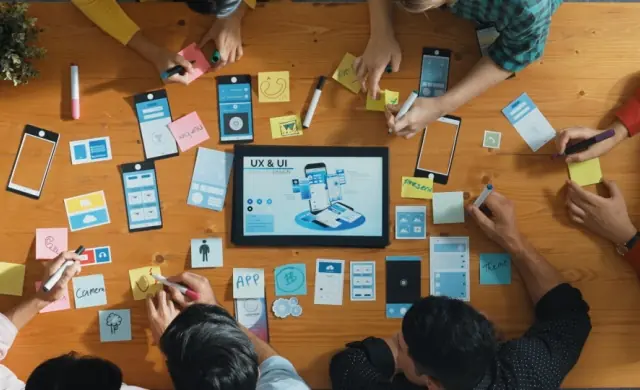
How Prototyping Enhances User Experience
Prototyping in UX design plays a pivotal role in shaping the final user experience by allowing designers to test, refine, and perfect their ideas. It offers a hands-on approach to improving usability and engagement, ensuring that the final product meets user needs. Here’s how prototyping impacts user experience.
Impact on Final User Experience
Prototyping in UX design allows designers to simulate user interactions with the product early on. This step helps identify and resolve issues with design elements like layout and functionality before full development. By testing responsive web design and other components, designers can ensure the product is user-friendly across different devices. Ultimately, the prototype in UX design helps refine the visual design and user interface, leading to a smoother and more enjoyable final user experience.
Iterative Prototyping for Better Usability and Engagement
Iterative prototyping is a process where designers continually improve the product through repeated testing and feedback. In action, this method follows the design thinking approach—prototype, test, refine, and repeat. By incorporating user feedback in each iteration, designers enhance the visual design and usability, leading to increased user engagement. Prototyping in UX ensures that the final product is polished and tailored to meet user expectations, fostering better long-term interaction and satisfaction.
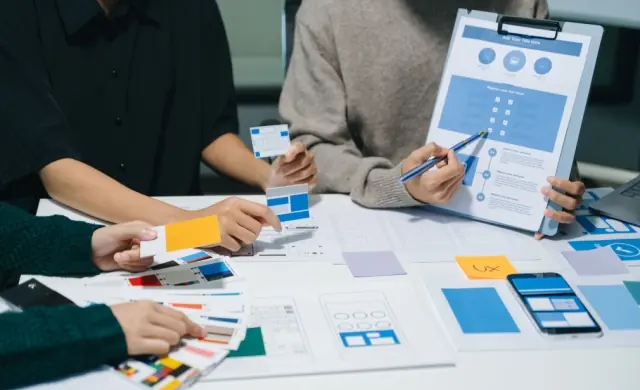
Why Businesses Should Invest in Prototyping Services
Investing in prototyping services can significantly impact the success of product development. Prototyping allows businesses to test and confirm ideas before committing to full production. This saves time and resources by identifying issues early. Companies use this proactive approach to create user-centered solutions that better meet customer needs. Here’s why businesses should consider this investment.
Commercial Reasons to Invest in Prototyping Services
Businesses gain several advantages by investing in professional prototyping services:
Cost Efficiency: Prototyping helps reduce costly errors by catching design flaws early. By using prototypes to test ideas, businesses can avoid costly revisions during full-scale development.
Faster Time-to-Market: Prototyping speeds up the development process. Designers can produce prototypes quickly without full coding. This enables businesses to adjust them rapidly based on feedback and complete projects faster.
Enhanced Communication: Prototypes visually show ideas, eliminating the need for lengthy documentation. Prototyping also improves communication between UX designers, stakeholders, and development teams. It ensures everyone stays aligned throughout the process.
User Validation: Additionally, prototypes help businesses gather user feedback early. This ensures the final product aligns with user needs and expectations. This iterative process refines the design and enhances the final user experience.
Outsourcing Prototyping for Faster and More Effective Development
Outsourcing prototyping services can lead to quicker and more efficient product development. It allows businesses to access external expertise. This frees internal resources and speeds up innovation. Specialized external teams focus on rapid iterations and user experience design. Businesses reduce the risk of costly development mistakes by testing design elements and gathering feedback early. They also improve market readiness and ensure the final product is polished and user-friendly. Check out our article on reasons to hire a UI UX design agency for more insights.
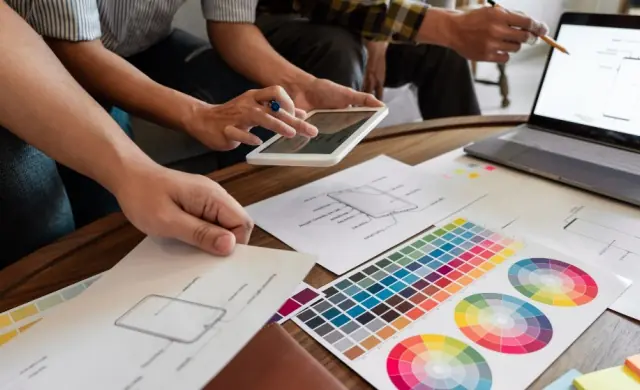
Choosing the Right Prototyping Partner
Selecting the right prototyping partner is crucial for creating a successful digital product. Businesses should look for a partner who can transform ideas into tangible solutions while ensuring user-centered designs. Here’s a guide to help you choose the best UX design company for your prototyping needs.
Tips for Selecting a UX Design Company
1. Experience
Look for a company with proven experience in UX prototyping. A strong portfolio showing a variety of successful projects indicates they can handle diverse challenges and deliver quality work across different industries.
2. Design Process
Evaluate their design process. The right partner should follow a structured approach that includes research, ideation, prototyping, and testing. This ensures your product is user-focused and effectively solves real problems.
3. User-Centered Approach
Choose a company that emphasizes user-centered design. They should incorporate user feedback at every stage of prototyping to ensure the product meets user expectations and delivers an optimal user experience.
4. Technical Expertise
The prototyping partner should have expertise in the latest tools and techniques. Whether it’s low-fidelity wireframes or high-fidelity interactive prototypes, they must be able to deliver designs that align with your business goals.
5. Unique UX Twist
Your partner should bring a unique UX twist to the table, differentiating your product from competitors. They should blend creativity with practicality to create innovative and user-friendly designs.
6. Strong Communication Skills
Ensure the company can communicate its ideas. Effective communication between UX designers, stakeholders, and developers is essential for a smooth design process.
7. Collaboration and Flexibility
Look for a team that is collaborative and flexible. They should be open to your feedback and willing to make adjustments as needed throughout the prototyping process.
8. Understanding of Business Goals
Your prototyping partner must understand your business goals. They should align their designs with your objectives to create a product that looks good and also achieves commercial success.
9. Focus on Visual Design
The partner should have a strong focus on visual design. They must be able to create aesthetically pleasing prototypes that appeal to users while maintaining functionality.
10. Problem-Solving Skills
Choose a partner who excels at problem-solving. They should be able to tackle design challenges head-on and come up with practical solutions during the prototyping phase.
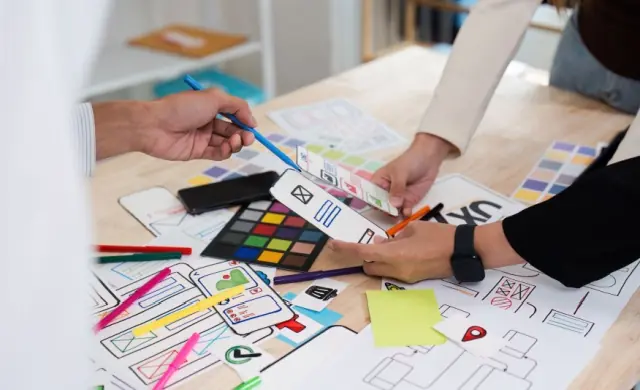
Unlocking UX Success with Prototyping in UX Design at ScreenRoot
Prototyping plays a crucial role in achieving successful UX design. It allows businesses to bring ideas to life before committing to full development. It helps UX designers simulate how a product will function, identify design flaws early, and refine user interactions. This iterative approach ensures the final product is user-centered, functional, and aligned with business goals.
By using various prototypes, such as low-fidelity wireframes or high-fidelity interactive models, designers gather user feedback and test usability. This process helps create seamless user experiences. Ultimately, prototyping saves time, reduces costs, and improves product outcomes and user satisfaction.
Businesses should invest in professional prototyping services. Doing so ensures products are designed with the end user in mind from the outset. Prototyping enables faster iteration, reduces costly development mistakes, and aligns stakeholders with the project vision. Early user involvement helps companies refine products to better meet user needs and stay competitive.
If you’re looking to elevate your product design, consider partnering with ScreenRoot, one of Clutch’s top-ranking UX design service providers and the winner of the UI UX Digital Agency of the Year 2024 award at the Great Indian BFSI Awards. Besides UI UX design, we also offer services such as enterprise application design, usability testing, and more. Visit our Work page to learn more.
📲 Text us on WhatsApp
📞 Call us at 1800 121 5955 (India)
📧 Email us at [email protected]
📋 Fill in the Contact Form
